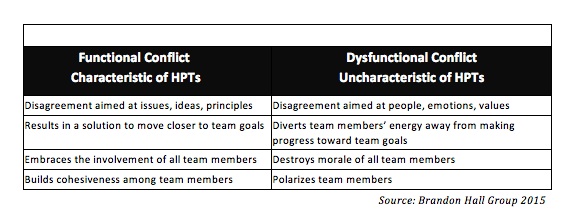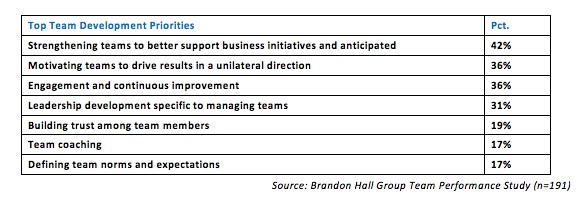
Approximately 72 percent of 191 organizations surveyed in Brandon Hall Group’s recent Team Development and Performance Study said team performance has a positive or extremely positive impact on overall productivity. Yet more than one-third (34 percent) of those same organizations said they do not have a strategy to improve team development, and 21 percent said they do not invest any time or resources of any kind to develop teams at any level within their organizations.
Key findings include:
5 Top Priorities for Team Development
- To enable business initiatives (42 percent)
- To drive results (36 percent)
- To continuously improve performance (36 percent)
- To promote leadership development in effective management of teams (31 percent)
- To build trust (19 percent)
Team performance is the result of more than one person working together toward achievement of a common goal. Results, specifically business results, are most impressive when teams are high-performing. High-performance teams (what we call Level 4 teams):
- Demonstrate mutual accountability for outcomes
- Leverage each individual’s strengths in complementary ways
- Are aligned on a single sense of purpose
- Strive for more aggressive goals than lower performance teams.
High-performance teams (HPTs) operate in the absence of any single person vested as the leader, and instead act collaboratively. They get over hurdles that others wouldn’t consider. They bring with them a spirit of unwavering commitment to master the challenge. As an HPT moves through the four team-development stages (forming, storming, norming, performing), they have more highly effective behaviors that allow them to overachieve in comparison to non-HPT teams. The top characteristics of HPTs are:
- Shared leadership: 31 percent
- Building trust: 19 percent
- Defining norms and expectations: 17 percent
- Resolving conflicts: 16 percent
Shared Leadership
In HPTs, the team leader is not one person in charge while the others follow. On high-performance teams, leadership is more than a role; it is an influence process that requires leadership from team members, as well as from the team leader. It is called shared leadership. The concept of shared leadership, therefore, runs counter to how team leaders operate in traditional (non-HPTs) teams. The foundation is that the influence process rests upon all team members sharing power and ideas up, down, and laterally rather than centralizing the power with a single person who acts in a clear role of a dominant superior. While few teams, or organizations, achieve shared leadership, our early evidence suggests that shared leadership can yield significantly greater organizational productivity and business results than a traditional model of team leadership does.
Building Trust
Trust is confidence, the absence of suspicion, and an ongoing record that confirms expectations of behavior and performance. Trust is expressed in the behavior toward others and will grow or shrink due to interactions and experiences. In general, trust-building is a slow process, between individuals and even more so among teams. HPTs accelerate it with communication among team members that is honest, open, consistent, and respectful.
Defining Norms and Expectations
HPTs are all about holding team members accountable for performance. To do so involves setting standards of performance, agreeing upon actions, and ensuring commitments are executed and results are met or exceeded. While most teams, at best, discuss performance norms and expectations, HPTs go the extra mile to document expectancies, and engage team members’ buy-in. HPTs typically document a “norms and expectations” charter.
Resolving Conflicts
Conflict arises from the clash of perceptions, values, or goals. Some common sources of team conflict are:
- Inconsistent values of team members
- Poor or negative attitudes of team members
- Misunderstood goals and expectations among team members
- Limited resources
- Unclear performance expectations
- Lack of communication
Conflict can be functional or dysfunctional. Functional conflict is healthy debate and an airing of opinion differences. It maximizes a team’s performance, and outcomes are better for it. When functional conflict upholds team performance and gets in the way of goal achievement, then it is dysfunctional. Managing that balance is essential. HPTs follow rigorous norms and an expectations guideline to ensure only functional conflict prevails.

High-Performance Results Rely on Team Development Strategy
Team performance requires careful execution of a team development strategy inclusive of structured teambuilding activities. Strategic planning and development is even more essential when building HPTs, but today 91 percent of organizations either have no team development strategy or one that is in early development.
Almost three-quarters of all organizations (73 percent) indicated they were not investing enough time and budget for team development. However, considering those few organizations with HPTs are consistently getting better business results than those without HPTs, we suspect we will see a significant investment uptick in teambuilding effort and activities.
For instance, 82 percent of HPTs in our research had a revenue increase of 1 percent or more, compared with just 61 percent of organizations with undefined or recently defined strategies. Some 64 percent of HPTs had most key performance indicators moving in a positive direction, compared to 48 percent of the other group. And 36 percent of HPTs reported an increase in employee engagement, compared to just 12 percent of the lowest-performing group.
Team Development Priorities and Approach
Team development generally occurs in three phases:
- Team assessment
- Team development sessions
- Team follow-up
Assessment determines the current dynamics of the team. Development is intended to accelerate team members’ skills to operate as a high-performance team. Follow-up with team members and the team lead allows for debriefing on the team’s performance and a review of the team’s results.
Let’s explore the development phase. To develop teams and optimize their performance, organizations train team members on the core competencies of working effectively on a team. To start, team members must be skilled in aligning team goals with business goals, accountability for results, continuous improvement and striving for better results, team leadership, accelerating trust among members, coaching each other, defining and communicating team expectations, conflict resolution, and working virtually across regional borders.

Today’s marketplace is defined by change leading to fundamental shifts in how organizations compete today and will compete tomorrow. To sustain business continuity and organizational performance, high-performance organizations require high-performance teams. Building teams, much less high-performance teams, requires rigor. It is not easy, but it is rewarding. The most effective organizations remind us that getting started and staying the course begins with common purpose, clear roles, and competent leadership.
Key Takeaways
- Have a common purpose. Establish a clear, common, and compelling reason for the team to exist. Outline the benefit of the team’s output to the organization, to the employees, and to individuals. Without the value proposition, team members have no reason to commit to the team.
- Define clear roles. Define the team’s strategy for cooperation. Assuming the team acknowledges a compelling reason to exist, next comes development and division of clear roles. Role clarity introduces the request for team member collaboration. Collaboration is a choice. Gaining buy-in to collaborate requires discussion—and lots of it—about who is accountable for what and about how everyone is accountable for ongoing performance and final results.
- Develop competent leadership. Invoke a shared leadership approach with a named team leader. The team leader governs completion of the work and achievement of the team’s goal by motivating exceptional work both by individuals and through collective and collaborative performance. Team leaders do not rely on positional authority to achieve results. They see team leadership as a role by which to serve the team, not a position of leadership.
Laci Loew is vice president and principal analyst for the Talent Management Practice at Brandon Hall Group, a human capital management research and advisory services firm that provides insights around key performance areas, including Learning and Development, Talent Management, Leadership Development, Talent Acquisition, and HR/Workforce Management.



